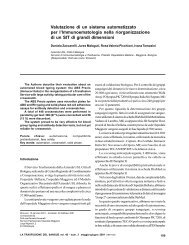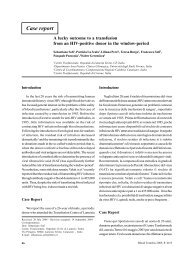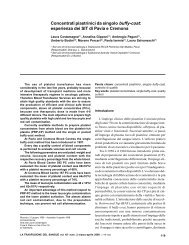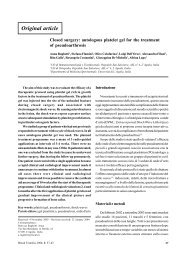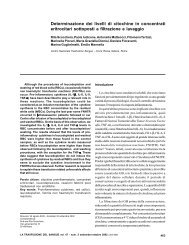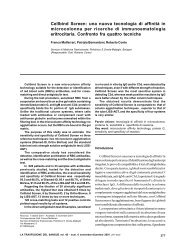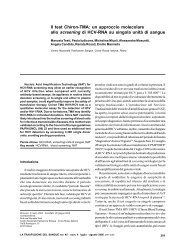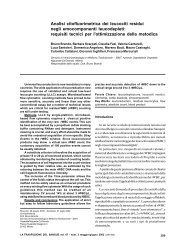Mitogen-stimulated DAT: a new method for the ... - Blood Transfusion
Mitogen-stimulated DAT: a new method for the ... - Blood Transfusion
Mitogen-stimulated DAT: a new method for the ... - Blood Transfusion
You also want an ePaper? Increase the reach of your titles
YUMPU automatically turns print PDFs into web optimized ePapers that Google loves.
W Barcellini et al.supernatant) or in cassettes (serum) with polyspecificanti-human globulin reagents. Enhancement solutions(PEG Gamma and Bliss Ortho) were used <strong>for</strong> screeningand identification of antibodies in eluates, culturesupernatants and serum, respectively. Positive resultswere recorded on a scale from 0.5+ to 4+ 20 . A 3-cell RBCpanel (Surgiscreen Ortho) and two 11-cell RBC panels(Ortho and Gamma) were used <strong>for</strong> serum antibodyscreening and identification, respectively.<strong>Mitogen</strong>-<strong>stimulated</strong> <strong>DAT</strong><strong>Mitogen</strong>-<strong>stimulated</strong> <strong>DAT</strong> was per<strong>for</strong>med as alreadydescribed 15,17 . Briefly, fresh heparinized blood sampleswere diluted 1:6 with RPMI 1640 medium (Gibco, GrandIsland, NY, USA) and ei<strong>the</strong>r un<strong>stimulated</strong> or <strong>stimulated</strong>with 2 µg/mL phytohaemoagglutinin (PHA) and 20 ng/mL Phorbol-12-myristate-13-acetate (PMA) (Sigma-Aldrich Chemicals, St. Louis, MO, USA), or 1%pokeweed (PWM) (Gibco) in 24 well-plates andincubated <strong>for</strong> 48 hr.The quantitation of IgG bound to <strong>the</strong> surface of RBCwas evaluated with a competitive solid-phase enzymeimmunoassay. Briefly, 96 well-plates (Falcon 3912, BectonDickinson, Oxnard, CA, USA) were coated with 50 µL ofhuman IgG (Sclavo, Siena, Italy) diluted at <strong>the</strong>concentration of 50 µg/mL in carbonate-bicarbonate buffer,pH 9.00, and incubated overnight at +4 °C.After washing three times with PBS containing 0.2%fetal calf serum (FCS, Hyclone Laboratories, Logan, UT,USA), plates were blocked with 200 µL of 2% FCS-PBS <strong>for</strong>2 hr at room temperature, and finally washed 3 times withPBS-0.2% FCS.A standard curve was constructed with group OCcDee RBC, obtained from a single blood donor,sensitised with serial dilutions of anti-D antibody(Immuno AG, Vienna, Austria) as previouslydescribed 17 .One hundred µL of both samples and standardswere incubated with an equal volume of peroxidaseconjugatedrabbit anti-human IgG (Dako, Glostrup,Denmark) diluted 1:3,000 in 0.2% FCS-PBS at 37 °C <strong>for</strong>30 min. One-hundred µL of this mixture were added to<strong>the</strong> IgG-coated plates in triplicate wells, and incubatedat +37 °C <strong>for</strong> 30 min.The plate was <strong>the</strong>n washed five times with PBScontaining 0.2% FCS and 0.05% Tween 20 (Merck,Darmstadt, Germany). Fifty µL of o-phenylenediamindihydrochloride (Sigma-Aldrich Chemicals, St. Louis,MO, USA) at a concentration of 0.5 mg/mL in 10 -1 M1:3.000 in 0,2%FCS-PBS. Le piastre venivano poi lavate 5volte con PBS contenente 0,2% di FCS e 0,05% di Tween20 (Merck, Darmstadt, Germania). A ciascun pozzetto sonostati poi aggiunti 50µL di una soluzione di ortofenilendiaminadiidrocloride (Sigma-Aldrich Chemicals, StLouis, MO, USA) alla concentrazione di 0,5 mg/mL in unasoluzione tampone 10 -1 M di acido citrico-citrato di sodio apH 4,8-5,0; è seguita incubazione a temperatura ambiente.Dopo 15 minuti, è stata misurata la reazione colorimetrica a450 nm, utilizzando uno spettrofotometro ELISA. Per ladeterminazione della presenza di anticorpi antieritrocitarisulle emazie autologhe poste in colture, le sospensionicellulari sono state trattate come emazie O CcDeesensibilizzate con anticorpi anti-D, mentre per ladeterminazione della presenza di anticorpi antieritrocitarisecreti, i supernatanti delle colture sono stati utilizzati persensibilizzare emazie O CcDee.Abbiamo costruito una curva standard su scalalogaritmica con i valori di densità ottica (OD) e dellaconcentrazione degli anticorpi anti-D (ng/mL); facendoriferimento a questa curva, sono stati calcolati i valori delleIgG legate ad emazie autologhe o la concentrazione deglianticorpi antiemazie nei supernatanti delle colture. È dasottolineare che il controllo positivo TAD standard davaun valore di IgG adese di 327±23 ng/mL (media±ES di 6esperimenti indipendenti).Al fine di fissare un cut-off per i valori positivi di MS-<strong>DAT</strong>, sono state calcolate le medie di 81 colture stimolatecon PHA, PMA e PWM di soggetti di controllo; la positivitàè stata definita come un valore che eccedesse la media più3 DS (220 IgG ng/mL).PazientiSono stati esaminati i seguenti soggetti: 1) 33 pazientiaffetti da MEA primitiva (idiopatica) con età media (±DS)di 50±12 anni, range 28-76, 20 femmine e 13 maschi e 2) 69pazienti affetti da B-LLC, età media 68±11 anni, range 41-89, 25 femmine e 44 maschi, la cui diagnosi era stata postaseguendo i criteri clinici, morfologici e immunologici diCheson et al. 21 e la cui stadiazione clinica era in accordocon le linee-guida proposte da Binet et al. 22 . Inoltre,abbiamo studiato altri 7 pazienti, con diagnosi presuntivadi MEA TAD-negativa posta in base all'esclusione di altrecause di emolisi e alla risposta clinica alla terapia consteroidi. Il test MS-<strong>DAT</strong>, insieme con la conta eritrocitariae i parametri emolitici (reticolociti, LDH e aptoglobina) èstato eseguito ogni mese su 8 pazienti affetti da MEA,seguiti regolarmente in regime ambulatoriale dal nostroDipartimento.130 <strong>Blood</strong> Transf 2003; 2: 127-36



